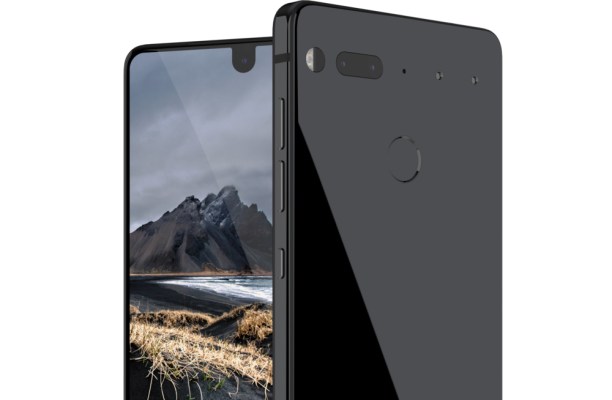Oh dear. “From “essential” to inconsequential in one partnership”, as one of my colleagues put it when told the news that Andy Rubin’s much hyped Essential smartphone is only going to be ranged by fourth largest US network, Sprint. “lol good luck” was another’s even more concise hottake.
USA Today quotes Essential president Niccolo de Masi spinning like a fidget spinner the revelation that Rubin’s hardware upstart — which, only last week, we heard had apparently raised $300 million in order to bring its smartphone to the masses — has in fact failed to secure the kind of widespread carrier distribution that is, dare I say it, essential for bringing smartphones to the masses.
“We like to bet with where we think the market is going as opposed to where the market was,” quoth de Masi. “I feel like we are a new brand and a new consumer electronics company and we are partnering with the network of the future.”
Feelings are great. It’s just that reality isn’t always very kind to them.
The Essential phone was unveiled at the end of last month, with a $699 price tag. And while consumers will still be able to fork that bundle of dollars out to get an unlocked version of the device, that’s not how mainstream smartphone marketshare is won. Just ask Google re: its Nexus smartphones.
Carrier distribution is a key make-or-break fact for hitting serious volume with U.S. released smartphones, as another colleague previously pointed out. Ergo, the Essential Phone is fast looking like little more than a very expensive vanity project.
Although, to be fair to Rubin, his head of product architecture, Jason Keats, did tell Wired the startup is not in a position to mass produce the phone — given that in Rubin’s overarching quest to address the “sea of products” infesting the tech space by, er, building more tech products, they apparently found themselves making purposefully obtuse design, engineering and manufacturing decisions because of the ‘mission impossible’ they are setting themselves (i.e. locating an iota of relevance in an entirely saturated smartphone market).
The phone itself is made from a blend of titanium and ceramic — we’re told on strength grounds — and has a screen sweet-spot-sized 5.6-inch display which also follows the bezel-squeezing trend; an 8MP front-facing camera which can record 4K video, and a 13MP rear lens with a second monochrome sensor to help boost low-light shots; while, under the hood, there’s a Qualcomm 835 processor, 4GB of RAM and 128GB of on-device storage.
Perhaps the most notable addition is a clip-on accessory that adds a 360 degree camera for people who want more ‘environmental bezel’ with their selfies. Though Essential is also working on a second product, a smart home hub, so its connected hardware ambitions do range beyond phones.
“We’ve gone after technologies and methods of manufacturing that aren’t designed to support 50 million devices,” Keats told Wired magazine at the end of last month. “We’re not for everybody. You know it’s going to be a little exclusive.”
Being ranged by one of the smallest carriers in the US — Sprint has been adding subscriber numbers in recent quarters but still lags Verizon*, AT&T and T-Mobile — does indeed sound like a “little exclusive”.
Sprint’s owner, SoftBank, previously dropped plans to invest $100M in Essential — reportedly due in part to the Japanese firm’s investment with Apple, via its $93BN Vision Fund. But USA Today says Rubin is an advisor to SoftBank’s fund — and, according to de Masi, friendly with CEO Masayoshi Son — so the pair of hardware lovers have evidently found a way to work together on Essential after all, despite competitive conflicts.
Even so, it seems unlikely Apple CEO Tim Cook will be losing much sleep over this partnership. Or indeed, much profit from the premium portion of the smartphone market that the iPhone has cornered.
* NB: TechCrunch’s parent AOL’s parent company is Verizon
